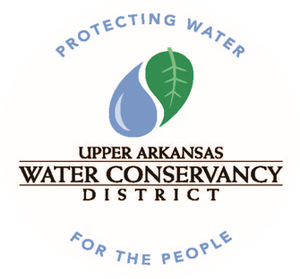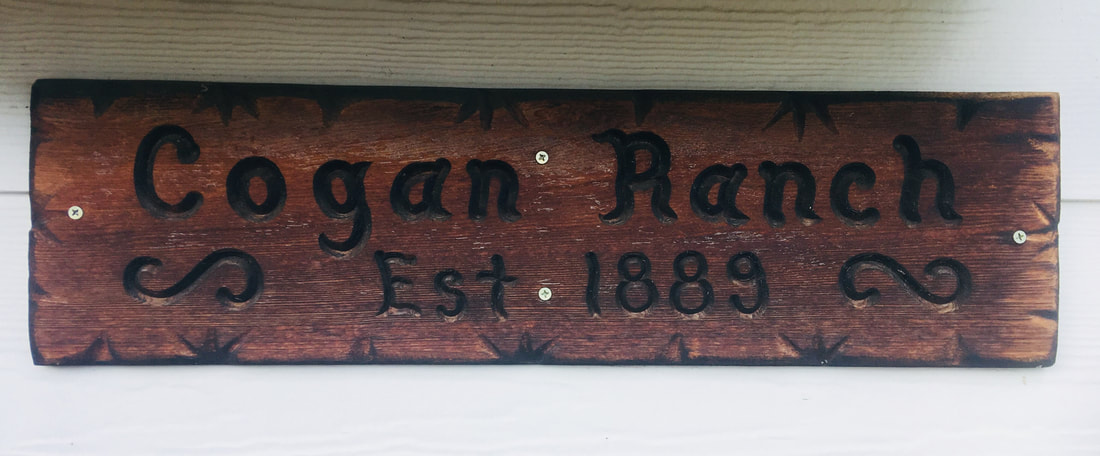|
Late last year we launched a new project at the Water District aimed at capturing the stories of local legends in the water community. We began by interviewing Ken Baker, the District’s Legislative Consultant. It was an honor to be entrusted with Ken’s story, which we shared in our January E-Newsletter and on our website.
In February we had the opportunity to sit down with Joe Cogan and hear more about his life and work in the Arkansas Valley. Joe was born on August 20, 1934 and is now 85 years old. He and his family are woven tightly into the fabric of the local ranching community, having lived and worked the land around Nathrop, CO that was purchased by Joe’s grandfather, Jeremiah Cogan, in 1889. Arriving at the Cogan property you can’t help but notice the old barns and ranching equipment that are clearly still in use. There’s also a wooden sign by the front door that reads “Cogan Ranch Est. 1889.” Our interview took place in Joe’s kitchen, and though you’d never guess it now, that same room served as the blacksmith’s shop back in 1889. Joe offered to build his wife Arlene a new house, but she was happy to stay put. Joe and Arlene were married around 1960 and have spent their entire married life in the same home. Like many ranching families, their children Brian, Bruce, and Laurie live close by. The Cogan family has been in Nathrop since 1883, when Joe’s father Jack immigrated with his family from Cork County, Ireland. Jack was 5 years old at the time. The Cogan’s spent their first winter on top of Fremont Pass, snowbound for 85 days, where Joe’s grandfather Jeremiah worked for the railroad. It was a rough winter and, seeking a warmer spot and easier living, Jeremiah moved his family down to Frisco. But Frisco proved to be just as harsh and, eventually, Joe’s grandfather returned to Nathrop with his family and started working for the Rio Grande railroad. In 1889 Jeremiah Cogan bought 120 acres from William Huey. The blacksmith’s shop, now Joe and Arlene’s kitchen, sat on this acreage. Jeremiah added on to the original homestead building, a space that now includes Joe and Arlene’s living room, and was able to claim a full 160 acres. In 1916 the government passed the national Stock-Raising Homestead Act, granting 640 acres for ranching purposes. Joe told us that people were starving to death on 160 acres and his grandfather added on another 640 acres to beef up their operations. Then, in 1929, Henry Feeling offered to sell his place to the Cogan’s and they purchased it for more hay ground. Unfortunately, this is right when the depression hit and everyone struggled. Folks had to lean on one another and, because there was little money, it was common to trade what you had for groceries. Joe comes from a large family, not uncommon for the time and place and way of life in which he was born. He is one of 7 children and the baby of the family. His mom Elizabeth was about 41 when he was born and his dad Jack was about 56. Apparently, after having Joe, his father declared, “This is the end!” Joe’s oldest sister has since passed away, along with one of his brothers. He has 4 siblings still alive, all between the ages of 98 and 85. Over the years the Cogan’s have continued to increase the size of their ranching operations, acquiring property throughout the valley and on the other side of Trout Creek Pass in Chubb Park. In 2009, having recognized the potential impact of property taxes on their operations, the Cogan’s worked with local non-profits and government agencies to permanently protect 507 acres in Chubb Park. These efforts not only support the Cogan family ranch lands, but also ensure that high mountain meadows will remain unspoiled for at least 100 years. During our conversation with Joe he repeatedly referenced his families 1872 water right, 2.4 cfs, as being key to the success of the ranch. The water rises in a spring and rarely freezes and Joe said his grandfather couldn’t have picked a better place in Colorado. One unique aspect of the Cogan property is the hydropower system that was installed by Joe’s father. Joe said his dad started thinking about hydropower around 1920 but he couldn’t make it work. He bought a broken bronze Pelton wheel and pipe from a source on Lake Creek and in time added a generator that had been used at 13,000 feet on Mt. Princeton. Eventually, Joe’s dad was able to generate 3 kwh of electricity at 220 volts and it was used for many years to power the property. Joe told us they had a wire in the house that could be pulled to drop a head gate and shut down the power when needed. The only problem with the set up was the dangerous nature of 220 volt direct current. Joe told us that sometime between 1970 and 1980 the pipeline was extended and the system switched to AC, which was much safer. With 68 feet of fall the Cogan’s were able to generate 9.9 kwh of electricity during irrigation season, which now services two houses, part of a third house, and provides hot water. When Joe talks about life on the ranch he does so with a mixture of pride, joy and pain. His body has been badly bumped and bruised after years of hard labor and he has trouble with both his back and his hip. He’s been milking cows since he was 7 years old and has done so when the temperature dipped to -52 degrees F. As a kid, Joe sold cream to help support his family. He also remembers his mom raising 300 chickens a year and said that one year the chickens brought in more money than 300 cows. He remembers his dad going to Denver to sell some cattle and the money he made was just enough to cover the cost of getting the cows to the sale barn. Times could be tight and life could be rough, but Joe said there’s no better place to live and no better way to make a living. He and his family have lived on the ranch a long time and have always done so in a conservative manner. He said that they haven’t spent a penny that they didn’t have and he was proud to report that at age 70 he paid off the last cow and the last piece of land. But wealth, says Joe, is more about loving where you live, how you live, appreciating your quality of life, and being close to people. When we asked Joe about the greatest threats to agriculture he said that was easy, it’s the impossible burger. That, and the inheritance tax. He said that ranches should be appraised on what they produce and, even though Joe and Arlene have already made decisions with their family on how things will be when they’re gone, they worry about things like the inheritance tax. Another thing that bothers Joe is what is happening to the mountains with the influx of so many people. He said that increased access has led to increased ruin. Back in the day Joe said people climbed mountains just to look around. Now, people try to conquer the mountains. After nearly 50 years on Search and Rescue Joe has hauled off both the living and the dead and has seen people get in way over their heads. He remembered one person saying they wanted to attack the mountain from the backside. Joe laments that the climbing of mountains has turned into a muscle contest with a lack of respect for the land. When we asked Joe about his closest friends he remembered his lifelong friend, Jack Acree. Jack was a USDA veterinarian and had a special knack with animals. He passed away last year and Joe said that life is pretty empty without him. Other good friends include and Nachtrieb’s and the McMurry’s. These families have toiled tightly over the years, sharing ditches and fences and working together to keep things in order on their ranches. As our interview with Joe came to a close we had the feeling that his stories could keep on going. Such a big life has been lived and we know that these details are only a scratch on the surface when it comes to the Cogan family and their legacy. It was an honor to be offered a bit of Joe’s time, to be welcomed into his home, and to be trusted with his stories. We hope learning a little more about the Cogan’s and the significant role they’ve played in this valley will serve to increase your appreciation and understanding of our local heritage.
1 Comment
|
ABOUTLocal water news by the Upper Arkansas Water Conservancy District Archives
August 2023
Categories |
CONNECT |
|
UAWCD Technology Accessibility Statement
UAWCD is committed to providing equitable access to our services to all Coloradans.
Our ongoing accessibility effort works towards being in line with the Web Content Accessibility Guidelines (WCAG) version 2.1, level AA criteria. These guidelines not only help make technology accessible to users with sensory, cognitive and mobility disabilities, but ultimately to all users, regardless of ability.
Our efforts are just part of a meaningful change in making all State of Colorado and local government services inclusive and accessible. We welcome comments on how to improve our technology’s accessibility for users with disabilities and for requests for accommodations to any UAWCD services.
Requests for accommodations and feedback
We welcome your requests for accommodations and feedback about the accessibility of UAWCD’s online services. Please let us know if you encounter accessibility barriers. UAWCD is committed to responding as quickly as possible.
E-mail: [email protected]
Mail: P.O. Box 1090, Salida, CO 81201
Phone: 719-539-5425 (Written requests are preferred. If you are unable to submit your request in writing, you are welcome to contact us by telephone at this number.)
UAWCD is committed to providing equitable access to our services to all Coloradans.
Our ongoing accessibility effort works towards being in line with the Web Content Accessibility Guidelines (WCAG) version 2.1, level AA criteria. These guidelines not only help make technology accessible to users with sensory, cognitive and mobility disabilities, but ultimately to all users, regardless of ability.
Our efforts are just part of a meaningful change in making all State of Colorado and local government services inclusive and accessible. We welcome comments on how to improve our technology’s accessibility for users with disabilities and for requests for accommodations to any UAWCD services.
Requests for accommodations and feedback
We welcome your requests for accommodations and feedback about the accessibility of UAWCD’s online services. Please let us know if you encounter accessibility barriers. UAWCD is committed to responding as quickly as possible.
E-mail: [email protected]
Mail: P.O. Box 1090, Salida, CO 81201
Phone: 719-539-5425 (Written requests are preferred. If you are unable to submit your request in writing, you are welcome to contact us by telephone at this number.)



 RSS Feed
RSS Feed